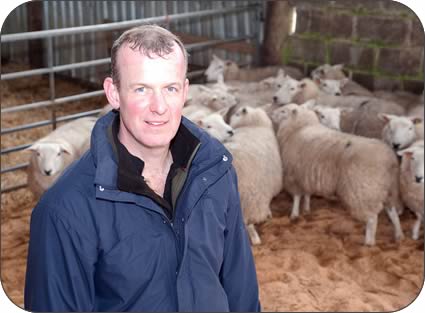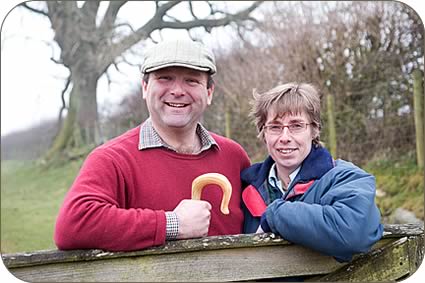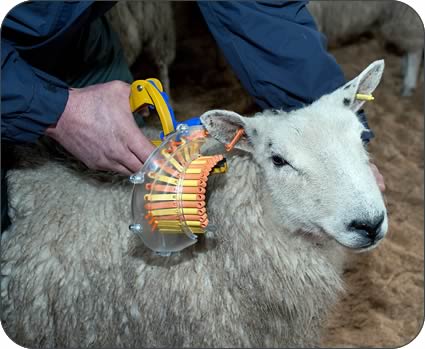Jennifer MacKenzie is an agricultural photo journalist with almost 30 year's experience. Operating from her base in Cumbria, Jennifer undertakes mainly industry-related freelance writing and photography.
Automatic Electronic Tagging System is the Way Forward
Ease of management for marketing and breeding purposes have led two neighbouring
Northumberland sheep producers to use the same automatic electronic tagging system.
David Ashbridge first began using an automatic sheep tagging system in
2002 when he worked for a neighbouring farm and since taking on the tenancy
of Wingates Moor Farm near Rothbury where his father Joe was previously
manager, he has continued to use them.
 |
David Ashbridge with his replacement ewe hoggs |
Convinced the automatic electronic tagging system is the way forward,
he introduced Selkirk-based Roxan’s TagFaster system to neighbour Jimmy
Bell ‘The Lamb Man’ who markets his own finished lamb and was
wanting to identify the ewes and rams which performed the best.
“I have used a variety of Roxan’s tags for breeding stock over
the years and they have all done the job. Brian Eadie is always looking
to make improvements on the tags,” said David, who farms 236 acres
at Wingates Moor and rents additional land and lambs 700 Texel cross and
Mule ewes to the Texel ram.
“We have used the senior double tags for breeding stock for the first
time on 180 replacement ewe lambs and even after four months we had not
lost any tags. Sheep are generally not good for retaining ear tags, particularly
when they are using ring feeders. I used another manufacturer’s tags
and within 10 days 10 tags were missing.”
 |
Kirsty and Jimmy Bell |
Brian Eadie has been designing and manufacturing sheep ear tags for the
last 20 years and since re-entering the sheep tag market in 2010, after
three years absence following the sale of some original tag designs, his
company, Roxan, is fast expanding again, and it has already gained a reasonable
share of the UK market.
Exports of his new designs are reaching New Zealand, Denmark, Italy, China,
Canada, USA, France, Estonia, and Australia.
David also uses electronic slaughter on all of his lambs from late June
to the end of the year with lambs tagged just before they are sold.
Depending on the trade, some are sold finished through Acklington mart
where in March this year they were among the top prices to average £77
a head and up to £85. Others go through the store ring at Hexham
where they are identified in the catalogue as being electronically tagged
which aids management and traceability for the buyer-finisher.
“When the lambs go through the store ring it’s an advantage
to the buyer for them to be electronically tagged. A specialist finisher
may be drawing lambs purchased from 20 different farms and instead of having
to look at the UK number on the tag he can easily read the tags with an
electronic reader to get the information for his movement sheet,” said
David.
By improved management and selecting the best ewes, David has lifted the
flock’s lambing performance by 15% to 182%. Ewes are scanned and
with the tups out for only two cycles the lambing which starts on March
22 is finished after 17 days, with the exception of 25-30.
“With the tags we have used in the past, we have had to be so careful
that the EID tag and the yellow management tags have the same number,” said
David.
“TagFaster’s unique system of ‘twins’ which are
a yellow EID tag and a year code visual pairs the tags in a strip of 20
so there is no way we can get the numbers wrong,” he said.
The tag applicator gun is quick to use and David uses a crate with a self
locking yoke. He can take up to 50 in 15 minutes.
“It has easily halved the time. It used to be a big job using two
piece tags. It is very quick to slot another strip of tags into the applicator,” he
added.
Improvements by Roxan have strengthened the tag pin while keeping its size
to a minimum which along with a ‘bridge’ design to maximise
ear space, helps prevent sores which then attract flies.
 |
Roxan TagFaster |
Jimmy and Kirsty Bell at neighbouring East Wingates Farm were persuaded
to try electronic slaughter tags to monitor the performance of their rams
and ewes to help maximise carcase quality of the lambs they sell direct
to the public.
The couple diversified their farming business in 1999 when they converted
a farm building into a butchery and cold store so that they could produce,
butcher and sell their lamb to customers at farmers’ markets and
via the internet, www.thelambman.com.
The farm has been in Countryside Stewardship for 20 years and is now undergoing
organic conversion. The closed flock of three quarter bred Texels is closed
with numbers running at 200 ewes and 50 hoggs which are being built up
to the size of the flock previously at 400 ewes. It is traditionally managed.
“We wanted to record the performance of rams in particular. We bought
a high index Charollais cross Texel ram from the Logie Durno flock, Aberdeenshire
and we wanted to easily record which rams went with which ewes and how
they performed for the butchery business,” said Jimmy.
The Bells also invested in a TGM Software Solutions electronic tag reader
which can then transfer data back to the farm’s computer.
This spring’s lambing which began in early April is the second lambing
for the system. Lambs are tagged with electronic slaughter tags at birth
and all are either retained as flock replacements or sold through the farm
butchery business. EID tags from Roxan have also been used on ewes to get
hem onto the electronic system
Kirsty has the post lambing system off to a fine art, armed with rubber
rings, iodine spray and tagging applicator gun which she carries in a bucket
between the individual lambing pens.
“The lambs don’t mind the tagging at all as they are not hard
or heavy. Because the lamb’s ears are so small you don’t want
them to be calloused with the tag. The tags have proved to have very good
retention,” said Kirsty. “They have also been very reliable
for retaining the electronic chip and it not being faulty. The gun is also
very easy to load.”
The lambs are slaughtered locally and while individual animals cannot be
identified by their carcase, the information from the tags from batches
of lambs slaughtered is enabling the Bells to see which lambs are finishing
soonest, how good their eye muscle is and monitor the right amount of fat
cover.
 |
Ease of Electronic Tagging |
The Charollais cross Texel ram tupped 73 ewes this season with the rest
covered by Texel rams bred in the north east by Hans Porksen and Donald
MacPherson. The flock scanned 181% and last year it made 163% lambs sold.
“We like to have a few single lambs which we start selling at the
farmers markets from mid August. After that we are slaughtering lambs every
week until the third week of February.
We like to keep our customers happy and provide them with ‘proper’ lamb.
We hang the first lambs for a week and then for a fortnight later in the
year.” said Jimmy.

